
IRIS login | Reed College home Volume 91, No. 1: March 2012
The Turmoil in Tibet

A Tibetan Buddhist nun looks out over Ganzizhou, in southwestern China’s Sichuan province, 2006. Tension between ethnic Tibetans and the Chinese government has risen in recent months.
AP Photo/Color China Photo
Reed anthropologist Charlene Makley examines the cultural collision between Tibetan Buddhism and Chinese capitalism.
By David Frazee Johnson

Charlene Makley, second from right, with Tibetan Buddist nuns in Labrang in 1996.
The film is short and shocking. Lobsang Konchok, an 18-year-old Tibetan monk from the Kirti Monastary in China’s Sichuan province, lies on the ground, smoke rising from his scorched skin. Horrified screams from passersby mingle with the sirens from emergency vehicles. His body twitches, showing faint signs of life. A Chinese security officer rushes into the frame, shouts “No filming!” and the screen goes blank.
Lobsang is one of a dozen Buddhist monks and nuns who have set fire to themselves in the past year to protest China’s policies towards Tibet. To most Americans, these desperate tactics mark a stunning departure from the philosophy of peaceful compassion that has made the Dalai Lama a worldwide spiritual leader.
To Reed anthropology professor Charlene Makley, they were sadly all too predictable.
![]()
Today’s Tibet, gripped by strife, is a far cry from the land that Makley first encountered in the mid-1980s as a freshly minted Middlebury graduate with a degree in French. Visiting Tibet, with its snow-capped mountains, dusty roads, and intense poverty, “was an eye-opening experience,” she recalls. China’s economic boom was focused in those days on the eastern part of the country, far from the Tibetan regions.
Despite the tense and sometimes violent relationship between Tibet and China, by the 1980s gradual reforms had created a spirit of optimism, she says. At one point she received an offer from Tibetan friends to open a school teaching English. “There was an ‘anything goes’ atmosphere,” she says. Soon after returning stateside, as she was preparing to go back to Tibet and open the school, she learned that a fresh round of protests had triggered a military crackdown. “The whole place shut down,” she says. “That spirit of openness was gone, and not coming back.”
By then hooked on Tibet, Makley pursued a degree in Asian studies at the University of Michigan, where she soon realized, almost by accident, that anthropology was a more natural discipline for her. “I had proposed an interdisciplinary PhD in anthropology–Buddhist studies,” she says, “but as soon as I started the anthropology classes, I knew that was where I belonged. These were my people.”
Having found her tribe in anthropology, Makley set about investigating the question that lies at the heart of modern Tibet: the conflict between China’s economic expansion and traditional Tibetan values of fierce autonomy.
She continued to explore this issue when she joined the Reed faculty in 2000. “When I arrived at Reed,” she recalls, “I felt as though I was entering this tiny new world.” The anthropology department at the University of Michigan was home to dozens of professors; Reed boasted five. At Michigan, intro courses were held in cavernous lecture halls; at Reed, a class of 20 students is considered crowded.
Nonetheless, she was floored by the intellectual capacity of Reed students. “What I discovered very quickly is that I loved the intellectualism, and the rigor with which students engage teachers here,” she says. “You can place the bar above the heads of students here, and they reach for it.”
Makley’s signature course is Anthro 362, “Gender and Ethnicity in China and Tibet,” which incorporates much of her field research in the valleys of Labrang and Rebgong in the Chinese provinces of Gansu and Qinghai, which lie outside the former nation of Tibet but inside the larger (and older) Tibetan areas of western China.
Makley’s primary interest lies in the rapid pace of economic development in China and the conflicts it has created in Tibetan society. “All the rhetoric from China looks fabulous,” she says. “They talk about freedom of religious belief, and progress, but then there has been this massive state-led development push, west, since 2000.”
The government is determined to exploit the natural resources of the vast Tibetan plateau, which Makley calls one of the last unexplored frontiers on earth. China’s hunger for timber, copper, lead, and zinc has put intense pressure on villages to sell land that has been in communal hands for centuries. Tibetan tradition holds that every mountain is inhabited by particular deities and demons, and inhabitants of the nearby villages are born into a lifelong spiritual relationship with these beings—relationships that are disrupted when the forests are felled and the land gouged by mineshafts. “Tibetans talk about being ‘swept east’ by the river of development,” Makley says. “They say, ‘There’s a wave, and we can’t stop it.”’
“With market-based development, you have increasing pressure,” Makley says. “People want to use land in new ways and villages are selling off land to outside bidders.” As Tibetans watch their lands auctioned off for the benefit of outsiders, often ethnic Chinese from the eastern regions, their resentment simmers.
In Rebgong, tension over the uneven distribution of wealth boiled over into widespread protests in 2008, triggering a severe crackdown by the authorities. “As Tibetans have become more polarized by market-based policies, sovereignty is being increasingly thought of as an ideal,” Makley says “People want, via the Dalai Lama, a modernized, Buddhist-informed nation-state. This is a type of Buddhism that the state wants to curtail. They want a sanitized Buddhism, where you have docile, obedient monks and not much else.”
The unrest reached a fever pitch in the run-up to the 2008 Olympics, when days of peaceful demonstrations led by Buddhist monks suddenly erupted in violence in Tibet’s capital, Lhasa, with protestors overturning and burning cars, smashing storefronts, and clashing with police officers. Several protestors were shot; many more were arrested. The unrest quickly spread to other Tibetan regions, despite the Dalai Lama’s appeal for calm. “The 2008 riot in Lhasa was shocking to people,” Makley says. “That footage was played all over the PRC.”
In the aftermath, the state media began for the first time to use the word “terrorist” to describe Tibetan dissidents, particularly Buddhist monks. According to Makley, the government is deeply troubled by the emergence of monks participating in street demonstrations. The official term, “superstition,” for beliefs and practices that lie outside of, and that are therefore not subject to, rigid state bureaucratic structures, she adds, literally means “to be lost or deluded into belief.”
As the state tries to confine the monasteries into a manageable role, young Tibetan monks are confronted with a stark reality. Historically, Makley says, “monasteries were not hermitages where monks would do nothing but meditate, but were monastic polities where Buddhism and governance were combined.” Some monasteries were essentially small towns, consisting of as many as 20,000 monks, who formed their own self-sufficient communities. No longer. Now, she says, “the role of monasteries as polities has been eviscerated, but many young monks think of their lamas as leaders who should still have that authority.” Unable to practice their religion to its full extent, watched everywhere by security forces, Tibetans are driven to desperate lengths.


LATEST COMMENTS
steve-jobs-1976 I knew Steve Jobs when he was on the second floor of Quincy. (Fall...
Utnapishtim - 2 weeks ago
Prof. Mason Drukman [political science 1964–70] This is gold, pure gold. God bless, Prof. Drukman.
puredog - 1 month ago
virginia-davis-1965 Such a good friend & compatriot in the day of Satyricon...
czarchasm - 4 months ago
John Peara Baba 1990 John died of a broken heart from losing his mom and then his...
kodachrome - 7 months ago
Carol Sawyer 1962 Who wrote this obit? I'm writing something about Carol Sawyer...
MsLaurie Pepper - 8 months ago
William W. Wissman MAT 1969 ...and THREE sisters. Sabra, the oldest, Mary, the middle, and...
riclf - 10 months ago